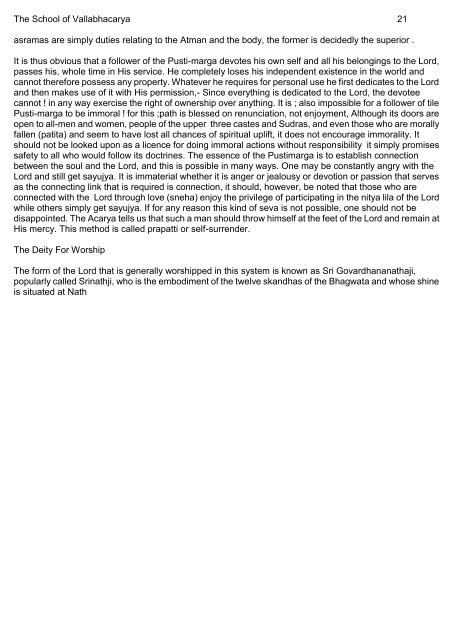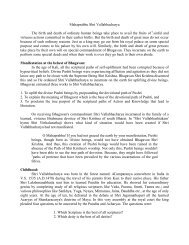Sri Vallabhacharya - Pushti Darshan
Sri Vallabhacharya - Pushti Darshan
Sri Vallabhacharya - Pushti Darshan
Create successful ePaper yourself
Turn your PDF publications into a flip-book with our unique Google optimized e-Paper software.
The School of Vallabhacarya 21<br />
asramas are simply duties relating to the Atman and the body, the former is decidedly the superior .<br />
It is thus obvious that a follower of the Pusti-marga devotes his own self and all his belongings to the Lord,<br />
passes his, whole time in His service. He completely loses his independent existence in the world and<br />
cannot therefore possess any property. Whatever he requires for personal use he first dedicates to the Lord<br />
and then makes use of it with His permission,- Since everything is dedicated to the Lord, the devotee<br />
cannot ! in any way exercise the right of ownership over anything. It is ; also impossible for a follower of tile<br />
Pusti-marga to be immoral ! for this ;path is blessed on renunciation, not enjoyment, Although its doors are<br />
open to all-men and women, people of the upper three castes and Sudras, and even those who are morally<br />
fallen (patita) and seem to have lost all chances of spiritual uplift, it does not encourage immorality. It<br />
should not be looked upon as a licence for doing immoral actions without responsibility it simply promises<br />
safety to all who would follow its doctrines. The essence of the Pustimarga is to establish connection<br />
between the soul and the Lord, and this is possible in many ways. One may be constantly angry with the<br />
Lord and still get sayujya. It is immaterial whether it is anger or jealousy or devotion or passion that serves<br />
as the connecting link that is required is connection, it should, however, be noted that those who are<br />
connected with the Lord through love (sneha) enjoy the privilege of participating in the nitya lila of the Lord<br />
while others simply get sayujya. If for any reason this kind of seva is not possible, one should not be<br />
disappointed. The Acarya tells us that such a man should throw himself at the feet of the Lord and remain at<br />
His mercy. This method is called prapatti or self-surrender.<br />
The Deity For Worship<br />
The form of the Lord that is generally worshipped in this system is known as <strong>Sri</strong> Govardhananathaji,<br />
popularly called <strong>Sri</strong>nathji, who is the embodiment of the twelve skandhas of the Bhagwata and whose shine<br />
is situated at Nath



